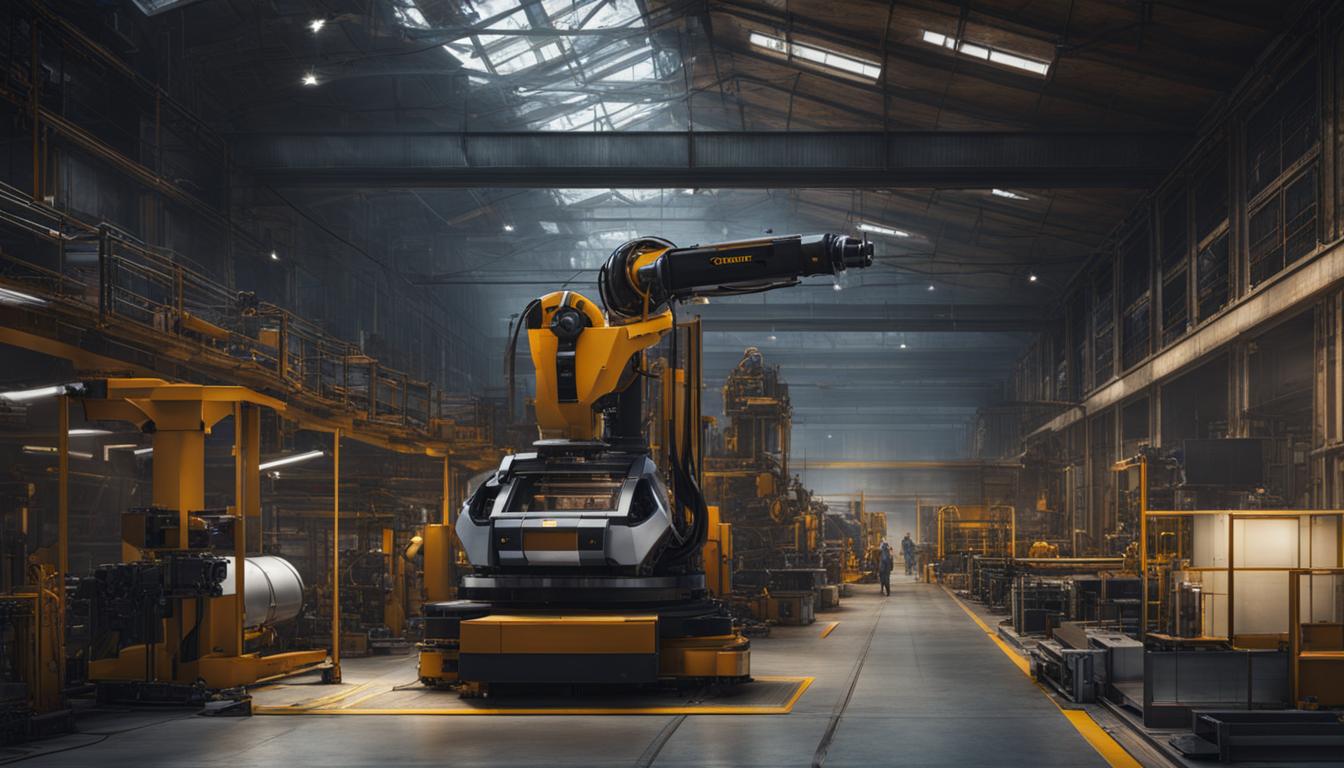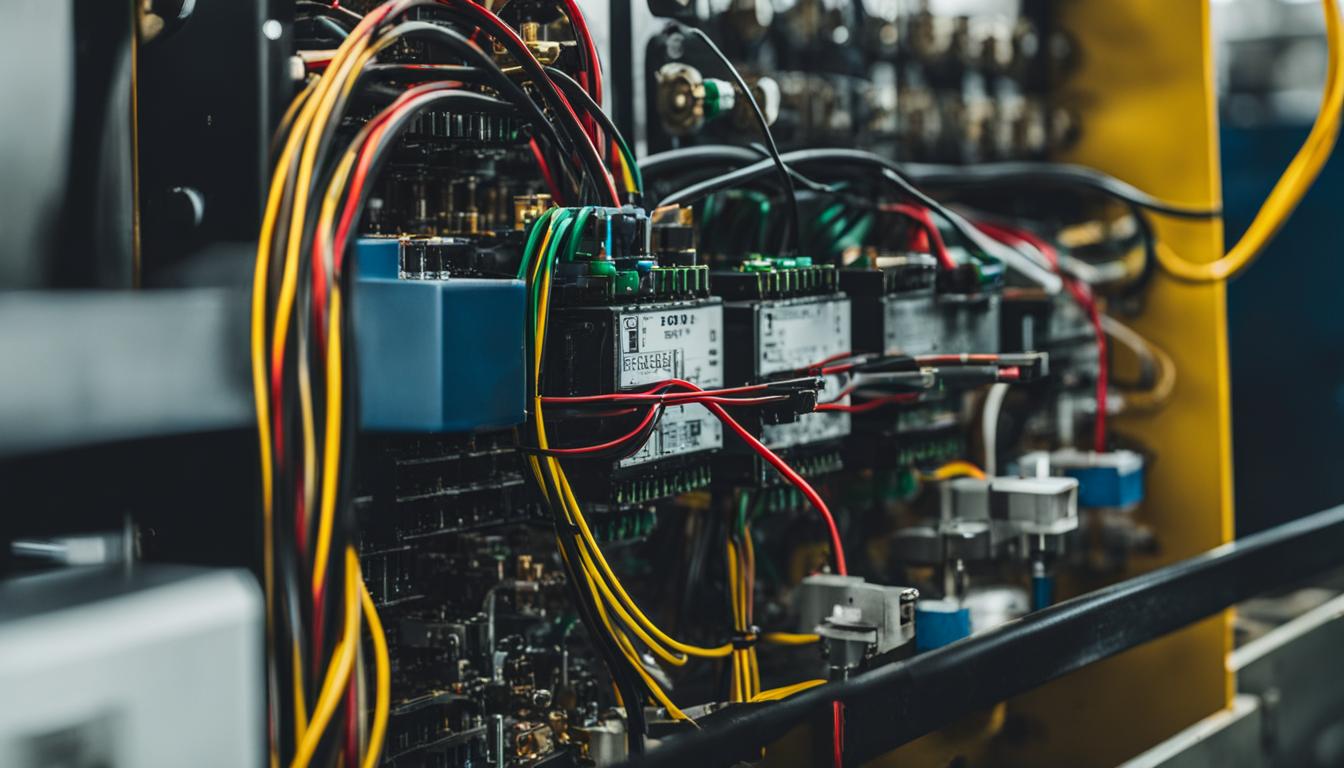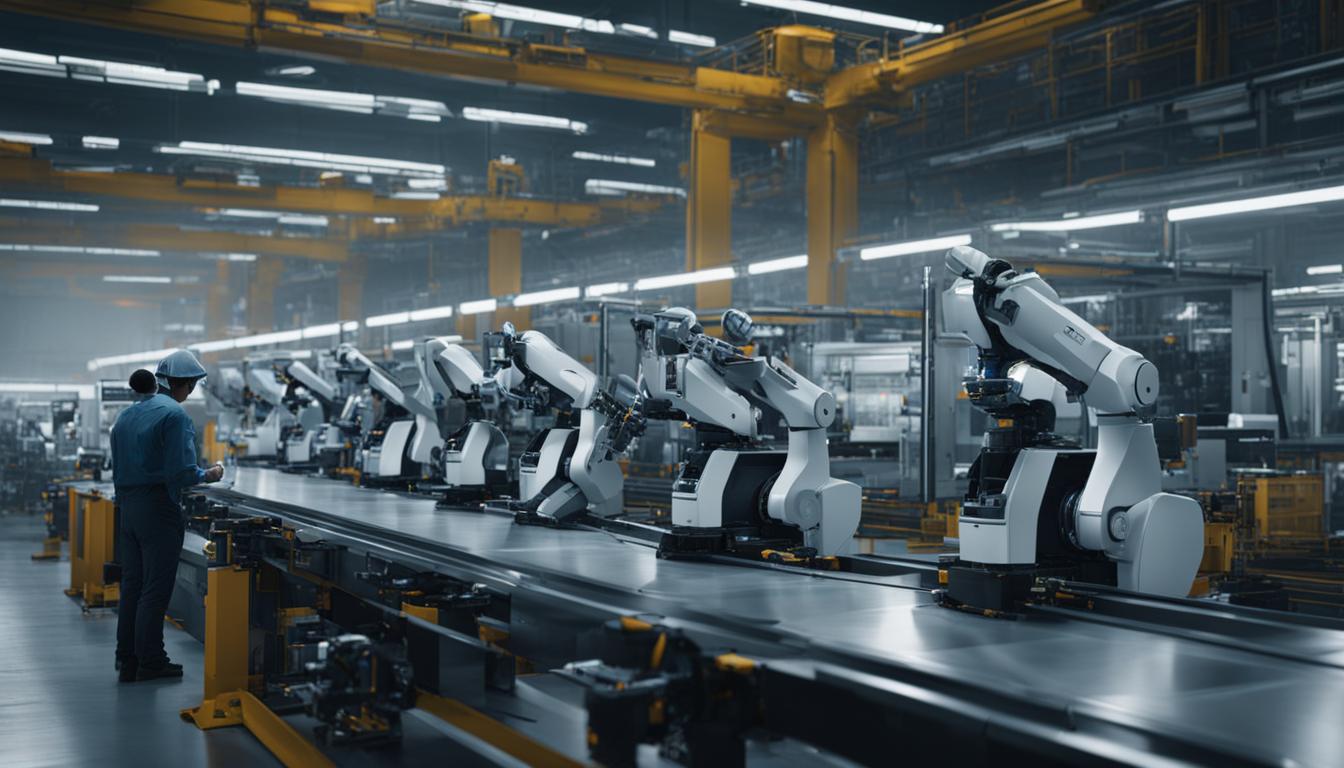Welcome to our article on 3D printing, a groundbreaking technology that has revolutionized the manufacturing and design industries. Also known as additive manufacturing, 3D printing has evolved from its early days of rapid prototyping to become a major player in industrial production. Companies like GE, Lockheed Martin, and BMW now use 3D printing at scale to create tangible products with superior efficiency and innovation.
The beauty of 3D printing lies in its ability to transform digital designs into physical objects. By using advanced 3D modeling and design techniques, manufacturers can create complex and customized products that were previously unimaginable. This digital fabrication process builds objects layer by layer, allowing for intricate designs and precise detailing.
3D printing offers a wide range of benefits, including greater flexibility, cost savings, and the ability to experiment with product designs. Rapid prototyping allows for quick iterations and improvements, resulting in enhanced product quality and faster time to market. The possibilities are endless when it comes to the materials that can be used in 3D printing, ranging from plastics and resins to ceramics, metals, and even stem cells.
In this article, we will explore the various applications of 3D printing across industries such as healthcare, aerospace, automotive, architecture, and construction. We will delve into the challenges and realities of 3D printing, as well as its future potential and advancements in speed, materials, and scale. So, let’s dive in and discover the exciting world of 3D printing!
Key Takeaways:
- 3D printing, also known as additive manufacturing, has revolutionized the manufacturing and design industries.
- It allows for the creation of complex and customized products, combining digital modeling and precise layer-by-layer fabrication.
- 3D printing offers advantages such as flexibility, cost savings, and enhanced product-design possibilities.
- Applications of 3D printing span across industries including healthcare, aerospace, automotive, architecture, and construction.
- The future of 3D printing looks promising, with ongoing advancements in speed, materials, and scale.
Understanding 3D Printing
3D printing, also known as additive manufacturing, is a revolutionary technology that allows the creation of three-dimensional objects layer by layer using a digital model. Unlike traditional manufacturing methods that involve cutting or molding, 3D printing builds objects from the ground up, enabling the production of complex and intricate designs.
This innovative process has gained widespread popularity for its ability to rapidly create prototypes, customize products, and produce spare parts. By utilizing digital models, 3D printing facilitates faster iterations and improved product quality.
With 3D printing, designers and engineers can push the boundaries of what is possible, creating intricate geometries and structures that were previously unattainable. This technology opens up a world of possibilities for artists, architects, and manufacturers, enabling the production of complex designs that were once mere concepts.
For example, companies in the aerospace and automotive industries can take advantage of 3D printing to create lightweight components with intricate designs, optimizing performance and fuel efficiency. In the healthcare sector, customized medical devices and implants can be manufactured to meet the specific needs of patients.
“3D printing is revolutionizing the way we manufacture and design products. Its ability to create complex and highly detailed objects opens up new possibilities for innovation and customization.”
By embracing additive manufacturing, industries can achieve greater flexibility, faster production times, and reduced material waste. The digital nature of 3D printing allows for efficient design iterations and cost-effective production.
With the continuous advancements in 3D printing technology and its expanding range of materials, the possibilities for innovation are endless. From aerospace to healthcare, architecture to fashion, 3D printing is transforming industries and pushing the boundaries of what can be achieved.
Benefits of 3D Printing
| Advantages | Explanation |
|---|---|
| Design Flexibility | Complex and intricate designs can be easily created. |
| Rapid Prototyping | Quickly develop prototype models for testing and validation. |
| Customization | Individualized products to meet specific needs and requirements. |
| Spare Part Production | Rapidly produce replacement parts on-demand, reducing downtime. |
| Reduced Material Waste | Only use the material required for the object, minimizing waste. |
As 3D printing continues to evolve, we can expect even more groundbreaking advancements and applications that will shape the future of manufacturing and design.
Applications of 3D Printing
3D printing has revolutionized various industries, offering innovative solutions and transforming traditional manufacturing processes. Let’s explore how 3D printing has made significant advancements in manufacturing, healthcare, aerospace, automotive, architecture, and construction.
Manufacturing: Rapid Prototyping and Customized Production
3D printing has unlocked new possibilities in manufacturing. It has revolutionized the concept of rapid prototyping by enabling companies to quickly produce physical models and test their designs before moving to mass production. This technology allows for faster iterations, reduced costs, and enhanced product development cycles.
Additionally, 3D printing enables customized product production, allowing companies to tailor products to individual customer needs. This level of personalization enhances customer satisfaction and provides a competitive advantage in the market.
Healthcare: Advancements in Medical Solutions
In the healthcare sector, 3D printing has made significant advancements, revolutionizing medical treatments and solutions. It has enabled the production of prosthetics that are customized for individual patients, enhancing mobility and improving the overall quality of life.
Dental implants, surgical tools, and implants can now be 3D printed, resulting in better patient outcomes and improved surgical procedures. The technology also holds the potential for organ printing, offering hope for patients awaiting organ transplants.
Aerospace: Lightweight Designs and Fuel Savings
3D printing has transformed the aerospace industry by introducing lightweight designs and fuel-saving innovations. With the ability to create complex geometries and intricate structures, 3D printing allows for the production of lightweight components without compromising strength and durability.
This not only reduces the weight of aircraft, leading to fuel savings and increased efficiency but also enables the production of optimized parts that were previously impossible to manufacture using traditional methods. 3D printing has proven to be a game-changer in aerospace engineering.
Automotive: Flexibility and Rapid Iterations
Automakers are leveraging 3D printing to enhance their production processes and accelerate innovation. The technology offers flexibility in design and enables rapid iterations, allowing automotive companies to quickly test and refine new ideas.
3D printing also plays a crucial role in after-sales support, as it allows for the production of spare parts on-demand, reducing inventory costs and minimizing downtime for customers. With 3D printing, automakers can achieve faster time-to-market and stay ahead in a highly competitive industry.
Architecture and Construction: Cost-Effective and Sustainable Solutions
In architecture and construction, 3D printing has the potential to revolutionize the way buildings are designed and constructed. It offers cost-effective and sustainable solutions, reducing material waste and construction time.
By utilizing 3D printing, architects and engineers can create complex designs and structures that were previously difficult or costly to build. This technology opens up new possibilities for sustainable construction and enables the construction of unique and innovative buildings.

3D printing is transforming the manufacturing landscape and pushing the boundaries of what is possible. Its applications in healthcare, aerospace, automotive, architecture, and construction continue to expand, creating new opportunities and driving innovation. As we explore the future of 3D printing, we can expect even more groundbreaking advancements that will revolutionize industries and reshape our world.
The Future of 3D Printing
In the world of manufacturing and design, the future is being reshaped by the advancements in 3D printing. With continuous innovations in speed, materials, and scale, this technology is revolutionizing the way we create and produce objects. According to market projections, the 3D printing industry is expected to experience significant growth, nearly tripling in value to reach $44.5 billion by 2026.
One of the most exciting aspects of 3D printing is its potential for diverse applications. From the creation of personalized food and fashion items to the production of intricate electronics and the exploration of outer space, the possibilities are vast. 3D printing empowers us to bring our imaginations to life, enabling unparalleled innovation in various industries.
“3D printing is drastically changing the rules of traditional manufacturing, offering a level of flexibility and customization that was previously unimaginable,” says Jane Thompson, a leading expert in additive manufacturing.
The ongoing advancements in speed allow for faster production cycles, shortening lead times and enabling agility in product development. With the ability to print with a wide range of materials, including plastics, metals, ceramics, and even biological substances, 3D printing opens up new frontiers for experimentation and breakthroughs.
Furthermore, the scalability of 3D printing presents exciting opportunities for large-scale production. Industrial sectors such as aerospace, automotive, and healthcare are leveraging this technology to create lightweight components, reduce costs, and improve efficiency.
Looking Ahead: Unlocking Innovation
As technology continues to evolve, 3D printing will disrupt traditional manufacturing processes, driving unprecedented levels of innovation. This transformative technology holds the potential to reshape entire industries and unlock new possibilities for businesses across the globe.
3D Printing in Construction
3D printing has quickly gained momentum within the construction industry as a game-changing technology. Recent advancements in load-bearing printable concrete have paved the way for efficient and cost-effective construction using 3D printing. This innovative approach to building has the potential to revolutionize the way we construct buildings, offering a range of benefits such as cost reduction, sustainable materials, and shortened construction time.
One notable example of the application of 3D printing in construction is the Charter Street project in Accrington, UK. This ambitious project aims to construct net-zero-carbon homes using 3D-extruded concrete, making it the largest printed building complex in Europe. By leveraging 3D printing technology, the project is able to achieve both environmental sustainability and cost savings, making it an attractive prospect for future construction endeavors.

In traditional construction methods, a significant amount of time and manpower are required to complete a building. However, 3D printing allows for the rapid fabrication of complex structures, eliminating the need for traditional assembly techniques. This not only reduces construction time but also minimizes human error and increases overall efficiency.
The use of 3D printing in construction also enables the use of sustainable materials. By utilizing load-bearing printable concrete, less raw material is wasted, resulting in reduced environmental impact. Additionally, the ability to produce custom designs and shapes using 3D printing allows for optimized material usage and reduced material waste.
Cost reduction is another significant advantage of implementing 3D printing in construction. The streamlined construction process, coupled with the potential for material savings, can result in significant cost savings for construction projects. This makes 3D printing an attractive option for developers and builders looking to optimize their budgets without compromising on quality.
Overall, the integration of 3D printing in the construction industry offers a glimpse into the future of sustainable, efficient, and cost-effective building practices. As the technology continues to advance, we can expect even more groundbreaking applications of 3D printing in construction, shaping the way we build and design structures.
The Challenges and Realities of 3D Printing
While 3D printing offers many advantages, it is not a one-size-fits-all solution. The technology excels in customization and lightweight design but may not be suitable for all manufacturing needs. Home usage of 3D printers has not reached the predicted levels, but the technology has found success in various industries such as healthcare, dentistry, aerospace, and automotive. It is a mature technology with a multibillion-dollar industry but has limitations that need to be considered.
One of the challenges of 3D printing lies in its customization capabilities. The ability to create highly personalized products is a major advantage, but it also requires specialized design skills and expertise. Companies may need to invest in training and education to fully harness the potential of 3D printing in their manufacturing processes.
Another limitation is the lightweight design aspect of 3D printing. While this is beneficial for certain applications, it may not be suitable for all industries and products. Heavy-duty machinery or load-bearing structures may still rely on traditional manufacturing methods due to the limitations of 3D printing materials and structural integrity.
Furthermore, the cost of 3D printing technology and materials can be a barrier for some businesses. While the prices have reduced over time, it may still be more economical for certain products to be manufactured using traditional methods. The scalability of 3D printing also poses a challenge, as it is not yet capable of mass production at the same level as conventional manufacturing processes.
Pros and Cons of 3D Printing
| Pros | Cons |
|---|---|
| Customization | Limitations in material availability |
| Reduced waste and environmental impact | Higher costs for equipment and materials |
| Rapid prototyping and iteration | Scalability challenges for mass production |
| Complex and intricate designs | Potential limitations in structural integrity |
| Opportunities for decentralized manufacturing | Specialized design and technical skills required |
Despite these challenges, it is important to recognize that 3D printing has found significant success in various industries. In healthcare, for example, it has revolutionized the production of customized medical devices and allowed for advancements in prosthetics and implants.
“3D printing has opened new doors in healthcare, enabling us to provide individualized solutions for patients with complex needs.” – Dr. Sarah Johnson, Head of Prosthetics at XYZ Hospital
In conclusion, while 3D printing offers exciting possibilities for customization and lightweight design, it is not without its limitations. Understanding these challenges is crucial for businesses looking to adopt 3D printing technology. By leveraging its strengths and overcoming its obstacles, organizations can harness the true potential of 3D printing and drive innovation in manufacturing and design.
Conclusion
3D printing has revolutionized the manufacturing industry, leading to a multitude of applications in sectors such as healthcare, aerospace, automotive, architecture, and construction. This transformative technology offers limitless possibilities for innovation and design.
The future of 3D printing holds great promise as advancements in speed, materials, and scale continue to push the boundaries of what is possible. The market for 3D printing is projected to nearly triple by 2026, indicating that its impact on the manufacturing industry will only continue to grow.
By embracing 3D printing, companies can unlock new opportunities for customization, cost reduction, and sustainability. Whether it’s producing complex medical devices, lightweight aerospace components, or architecturally intricate structures, 3D printing offers a flexible and efficient solution.
As technology evolves, we can expect even more groundbreaking advancements in the world of 3D printing. By harnessing the full potential of this technology, the manufacturing industry can thrive in an era of innovation, pushing the boundaries of what is possible and shaping the future of design and production.
FAQ
What is 3D printing?
3D printing, also known as additive manufacturing, is the process of creating three-dimensional objects layer by layer using a digital model. Unlike traditional manufacturing methods, 3D printing builds objects from the ground up, enabling the creation of complex and intricate designs.
How is 3D printing used in the manufacturing industry?
3D printing has revolutionized the manufacturing industry by enabling rapid prototyping, customized product production, and decentralized manufacturing. It allows for faster iteration and improved product quality.
What are the applications of 3D printing?
3D printing has diverse applications in various industries. In healthcare, it has been used for advancements in prosthetics, dental implants, surgical tools, and potential organ printing. The aerospace industry benefits from lightweight designs, fuel savings, and innovation in engineering. Automakers leverage 3D printing for flexibility, rapid testing, and after-sales support. In architecture and construction, 3D printing offers cost-effective, sustainable solutions and allows for complex designs and reduced construction time.
What does the future hold for 3D printing?
The future of 3D printing looks promising with ongoing advancements in speed, materials, and scale. The market for 3D printing is projected to nearly triple by 2026, with a value of $44.5 billion. As technology continues to evolve, 3D printing will continue to disrupt traditional manufacturing processes and unlock new frontiers of innovation.
How is 3D printing being used in the construction industry?
Recent developments in load-bearing printable concrete have made it possible to 3D print buildings efficiently and cost-effectively. This technology offers potential cost savings, sustainability, and reduced construction time.
What are the challenges and realities of 3D printing?
While 3D printing offers many advantages, it is not a one-size-fits-all solution. The technology excels in customization and lightweight design but may not be suitable for all manufacturing needs. It has found success in various industries such as healthcare, dentistry, aerospace, and automotive, but it has limitations that need to be considered.
How has 3D printing revolutionized the manufacturing industry?
3D printing has revolutionized the manufacturing industry by offering advantages such as greater flexibility, cost savings, and enhanced product-design possibilities. It has transformed industries such as healthcare, aerospace, automotive, architecture, and construction, driving innovation and unlocking new opportunities.




